Environmental accounts – Environmental pressures from consumption 2023
Greenhouse gas emissions from Swedish consumption decreased in 2023
Statistical news from Statistics Sweden 2025-10-21 8.00
Greenhouse gas emissions from Swedish consumption (which includes private consumption, public consumption, and gross investments) decreased by 9 percent in 2023 compared with 2022. Emissions embedded in products Sweden imports decreased by 13 percent at the same time that consumption-based emissions arising from Swedish production decreased by 3 percent.
- Our calculations of greenhouse gas emissions from Swedish consumption show a reduction of 8 million tonnes of carbon dioxide equivalents in 2023 compared to 2022 says Johanna Takman, analyst at Statistics Sweden.
The reduction in emissions between 2022 and 2023 is primarily due to decreased gross investments and a decline in private consumption of product groups that generally have high consumption-related emissions. Regarding emissions linked to gross investments, the largest reduction occurred in construction, where a decrease in new construction was a key factor. Additionally, the reduced emissions from gross investments were mainly due to reduced inventories. In terms of private consumption, the largest emission reductions were seen in products such as food and beverages, textiles, clothing, and furniture. Minor emissions increases occurred for air transport and electricity and heating.
Greenhouse gas emissions from Swedish consumption amounted to 80 million tonnes of carbon dioxide equivalents in 2023, a reduction of 9 percent compared with 2022. During the same period, domestic final demand[1] in Sweden decreased in monetary terms by 0.5 percent. Accordingly, the greenhouse gas emissions intensity (emissions per SEK of demand) decreased by 8.9 percent. Consumption decreased primarily within product groups with higher emission intensities, while consumption of services increased, where emission intensities are generally lower. This contributed to Sweden’s consumption-based emissions in 2023 decreasing more than Sweden’s consumption measured in monetary terms.
The COVID-19 pandemic in 2020 led to a decline in both the economy and emissions. Emissions resulting from Swedish consumption increased again in 2021 and 2022, but in 2023, emissions once again fell to the levels seen in 2020.
[1] (sum of household consumption, public consumption and gross capital formation)
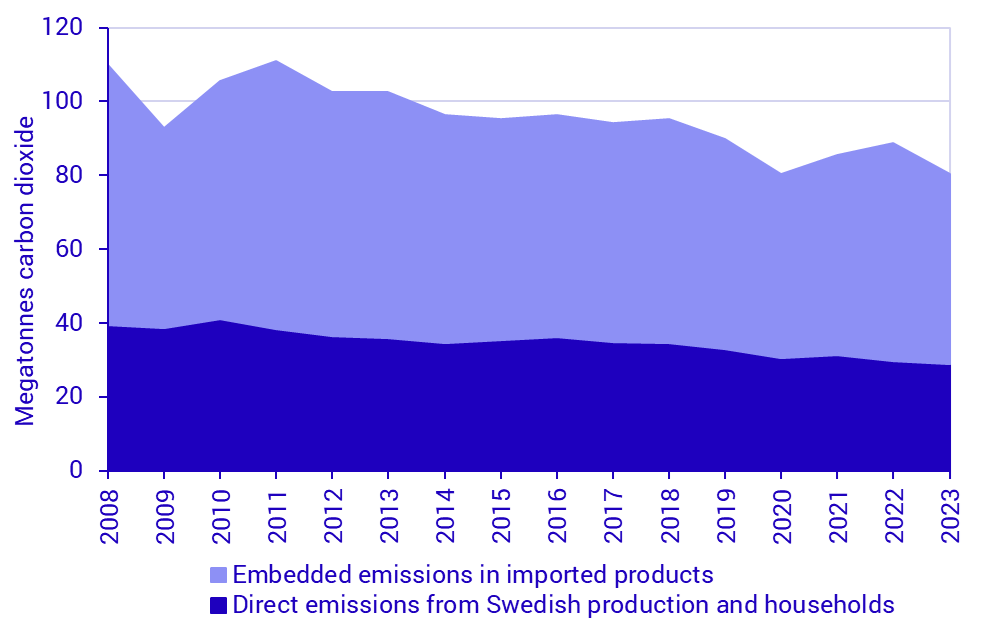
Source: Statistics Sweden
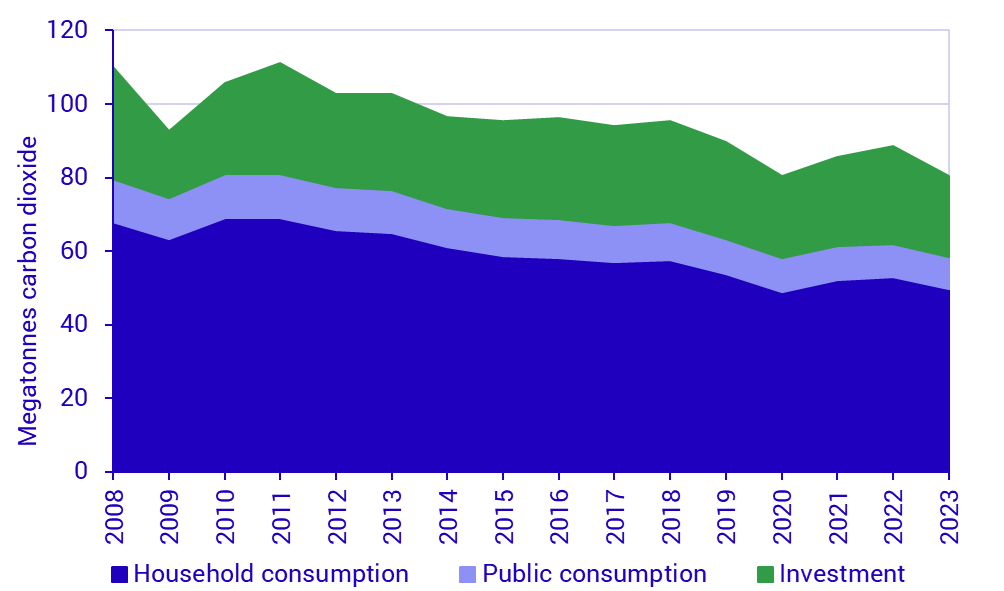
Source: Statistics Sweden
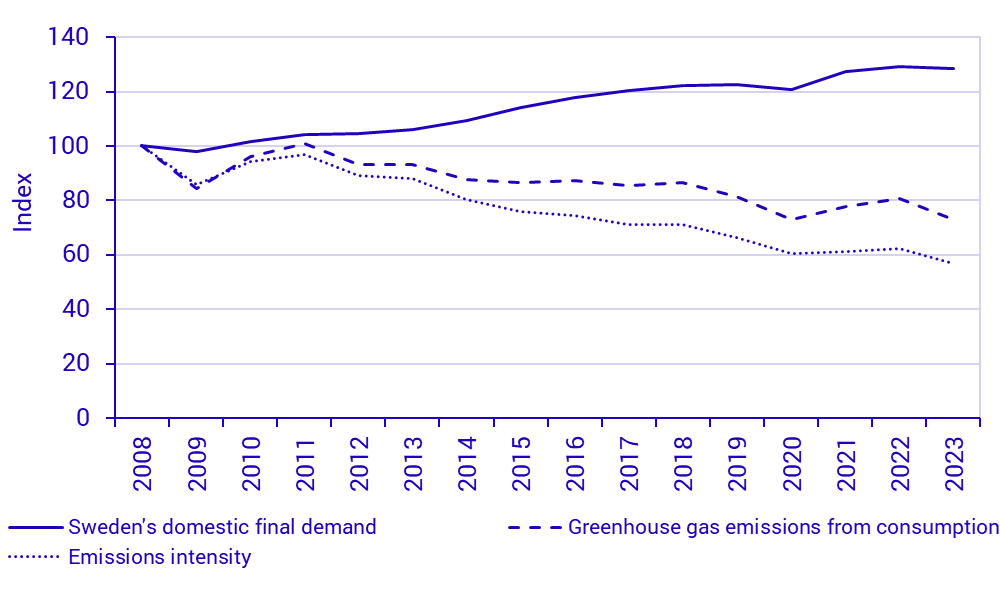
Source: Statistics Sweden
Greenhouse gas emissions from consumption in 2023 in brief
The reduction in emissions is primarily visible in gross investments and household consumption. Percentages are compared to the previous year, unless otherwise stated. Emissions refer to greenhouse gas emissions and are measured in million tonnes (Mton) of carbon dioxide equivalents, unless otherwise specified.
Greenhouse gas emissions embedded in Sweden’s gross investments decreased by 4.6 million tonnes, 17 percent. The reduction is mainly due to changes in inventories (for the product groups other machinery, chemicals and pharmaceuticals, steel and metal production, and metal products excluding machinery and equipment) and decreased investments in construction products.
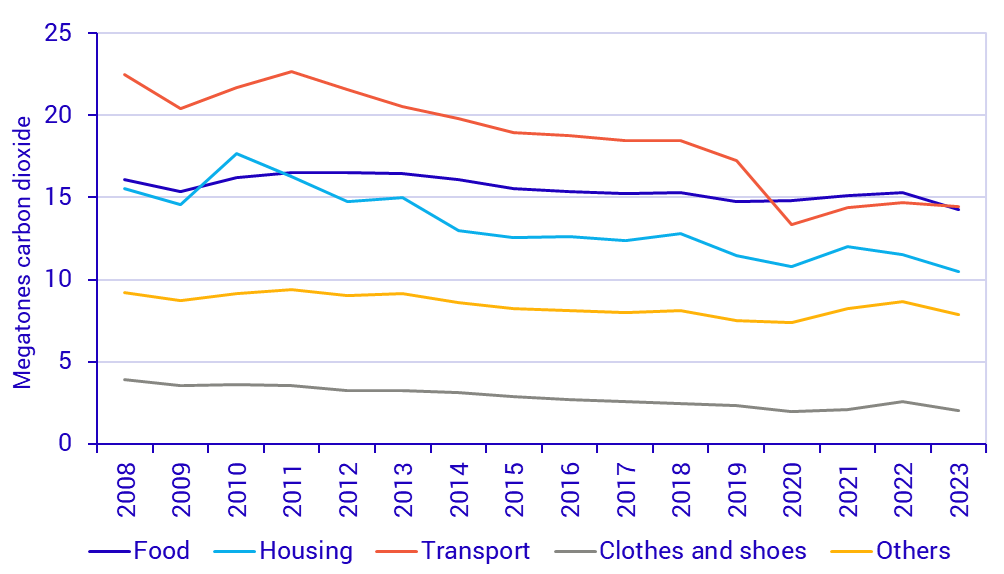
Source: Statistics Sweden
Greenhouse gas emission embedded in household consumption decreased by 3.5 million tonnes, 6.6 percent. All subcategories of household consumption showed decreases.
- Food: -1.0 Mton, -6.4 percent
- Housing: -1.0 Mton, -8.6 percent
- Transportation: -0.2 Mton, -1.6 percent
- Clothes and shoes: -0.5 Mton, -21 percent
- Other: -0.7 Mton, -8.7 procent
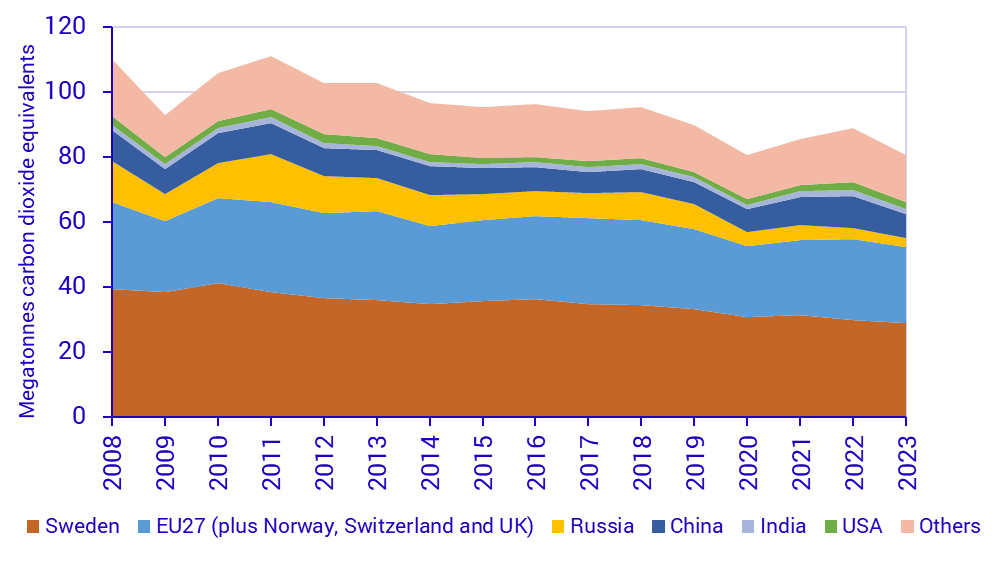
Source: Statistics Sweden
Greenhouse gas emissions embedded in imported products decreased by 7.4 million tonnes, 13 percent, while emissions arising from Swedish production and households decreased by 0.8 million tonnes, corresponding to 3 percent. Percentagewise embedded emissions decreased most from China — by 26 percent, which corresponds to 2.5 million tonnes. For other countries whose products are included in Swedish imports, embedded emissions also decreased:
- EU countries (including Norway, Switzerland and the United Kingdom): -1.5 million tonnes, -6 percent
- China: -2.5 million tonnes, -26 percent
- Russia: -0,7 million tonnes, - 20 percent
- India: -0.2 million tonnes, -12 percent
- USA: -0.2 million tonnes, -7 percent
- Other countries and regions: -2.3 million tonnes, -14 percent.
Revisions
The entire time series for statistics on environmental pressures from consumption is updated with each annual publication. In this publication, revisions have been made to the underlying data, which leads to differences compared to previous releases.
Revision of economic data from Statistics Sweden’s national accounts
With each annual publication, revisions are implemented for the entire time series of the National Accounts statistics on production, intermediate consumption, final use, and foreign trade in Sweden’s economy. This also leads to revisions in the statistics on environmental impact from consumption.
In 2025, the National Accounts applied a minor review, which mainly affects data from 2021 onwards.
Our methodology for statistics production uses the most recent time series with product breakdowns from the National Accounts. Every five years, a general review of the National Accounts is conducted. Each review revises the entire time series for the National Accounts main aggregates, but not for detailed product variables. As a result, there are two time series breaks of National Accounts data used as input for these statistics: one between 2014 and 2015, and another between 2020 and 2021. Comparisons between these years should be made with caution.
Revision of data on greenhouse gas emissions from Swedish production
Revisions have been applied in the calculation of Sweden’s production-based emissions:
- Several new emission factors have been introduced due to revisions in IPCC reporting, especially for particulate matter.
- A new calculation method for waste emissions has been implemented for the entire time period. A new allocation factor between emissions from fossil and biogenic sources has been applied starting in 2022.
More information on these updates can be obtained from the product page: System of Environmental and Economic Accounts.
Revision for calculation of environmental pressures from Sweden’s imported products
Statistics Sweden uses the global multi-regional input-output database EXIOBASE to calculate emissions from Sweden’s imported products.
SCB uses the global multiregional input output database EXIOBASE to estimate emissions arising due to Sweden’s imports. The database is developed and maintained by a consortium led by the Norwegian University of Science and Technology.
For this year’s statistics production, EXIOBASE version 3.8.2 has been used. More information on EXIOBASE is available here:
https://zenodo.org/records/14614930
https://onlinelibrary.wiley.com/doi/abs/10.1111/jiec.12715
For the reference years 2021–2023, emission multipliers for embedded emissions in imported products have been extrapolated from the reference year 2020. This was done due to missing data for 2023 and quality issues in EXIOBASE for 2021 and 2022. In connection with this, data from the National Accounts on Sweden’s total final use for 2021–2023 has been used in constant prices for this calculation.
Result of revisions
The above revisions have had some impact on emission levels for all years in the time series. The greatest impact is seen in the emission levels for 2022. Due to the revisions, greenhouse gas emissions from Swedish consumption in 2022 are estimated to be 0.3 million tonnes of carbon dioxide equivalents higher compared to the statistics for 2022 prior to the revisions.
For Sweden’s greenhouse gas emissions from consumption that originate directly from domestic production and households, the revisions in the 2025 production round resulted in changes ranging from -266 to 64 kilotonnes of carbon dioxide equivalents depending on the year, compared to the corresponding emissions in the 2024 production round. This corresponds to a total difference of between -0.8 to 0.2 percent depending on the year. The time series trend is only marginally affected.
For Sweden’s greenhouse gas emissions embedded in imported products, the revisions in the 2025 production round resulted in an average increase of between 46 to 401 kilotonnes of carbon dioxide equivalents depending on the year, compared to the corresponding emissions in the 2024 production round. This corresponds to a total increase of between 0.1 to 0.6 percent depending on the year. The time series trend is only marginally affected.
Definitions and explanations
These statistics form part of the environmental accounts. The environmental accounts are based on the National Accounts and present national environmental statistics and economic statistics in a common framework. Environmental data is systematised according to the same industry classification and areas for final use as economic data. The main goal of this systematisation is to analyse the relationship between economic and environmental performance.
The National Accounts measure gross domestic product in two different ways – from a supply perspective and from a demand perspective. The environmental accounts also measure the gross domestic product, but from an environmental perspective. Where the production perspective answers the question – “who is emitting?”, the consumption perspective answers the question “who benefits from the emissions?”
The method used to produce these statistics is based on environmentally extended input-output analysis, using the framework of the national accounts. This approach is based on the results of a recently completed research project, PRINCE (Policy Relevant Indicators for Consumption and Environment). See also Palm et al. 2019.
Statistics on environmental pressure from consumption show environmental pressure in relation to the macroeconomic balancing equation that is the basis for the national accounts. The equation for Sweden’s balance is as follows:
P+M = C + G + I + E
Equation 1
in which P is Sweden’s GDP, M are total imports to Sweden, C is household consumption, G is general government consumption, I is gross capital formation, and E is total export to other countries from Sweden. According to the system of national accounts, all variables are presented in monetary terms. The statistics presented in this publication show greenhouse gas and other air emissions for each term in the equation. For each term, the environmental pressure is allocated to 50 different product groups, including households’ direct emissions.
For household consumption, environmental pressure is presented according to the international COICOP allocation (classification of individual consumption by purpose).
Relationship to other official emissions statistics
Official statistics on greenhouse gas and other air emissions are presented from three complementary perspectives:
- From Sweden’s economy with a consumption perspective (these statistics)
- From Sweden’s economy with a production perspective
- From Sweden’s territory (territorial statistics)
Statistics Sweden is responsible for statistics with a production and consumption perspective, as a part of the system of environmental economic accounts. Statistics with a consumption perspective are unique since they present environmental pressure for all goods and services that are produced and used in the Swedish economy along their entire production chain. This is particularly interesting for Sweden since a large proportion of goods and services that are used in the Swedish economy are imported. Sweden also exports a large proportion of the domestic production.
Environmental accounts’ official statistics from a production perspective present greenhouse gas and other air emissions from the Swedish economy’s total domestic production of goods and services by sector. This system boundary represents the P-term in Equation 1 above and includes Swedish economic actors’ environmental pressure irrespective of where in the world the pressure occurs.
The Swedish Environmental Protection Agency produces official territorial statistics, presenting those environmental pressures that occur within Sweden’s borders.
All of the statistics mentioned are included in Sweden’s official statistics and they follow uniform guidelines for when and how the statistics are published, quality assurance, and documentation.
Results differ between different official statistics
The different system boundaries that are applied in the production of statistics from the three different perspectives lead to differences in the absolute emissions levels as shown in the statistics. Air emissions from a production perspective include virtually all air emissions included in territorial statistics, as well as emissions from international transport operated by Swedish economic actors. Therefore, emissions from a production perspective are in practice greater than emissions from a territorial perspective, which exclude emissions from international transport.
Sweden’s imports and exports are almost exactly balanced, with exports being slightly greater. At the same time, the greenhouse gas emissions intensity (emissions per unit production in monetary terms) for domestic production is lower in Sweden than in Sweden’s major trading partners. This means that greenhouse gas emissions presented in statistics with a consumption perspective are larger than in statistics with a production perspective, even when emissions from Sweden’s export are excluded.
The different official statistics can also be used for different purposes. Statistics from environmental accounts can be used to support policy analyses from an economic and environmental perspective, or investment and procurement decisions.
Territorial statistics are used to follow the development of emissions in relation to climate change goals in Sweden, the European Union and the United Nations. These statistics show which emissions sources are present in the country. Countries therefore have significant jurisdiction over laws and regulations that can affect emissions and can easily perform calculations of national reduction targets.
More information about the different perspectives:
Statistics Sweden, environmental accounts’ air emissions accounts:
Statistics Sweden, environmental accounts’ environmental pressures from consumption:
The Swedish Environmental Protection Agency and Statistics Sweden’s joint description of the statistics (in Swedish):
Glossary of selected terms:
Household consumption
Consumption by households and private citizens. Includes non-profit institutions serving households (NPISH).
General government consumption
Consumption by state, county and municipal authorities.
Investments
Investments by general government and industry, for example procurement of machines, buildings and roads. Investments can be subdivided into gross fixed capital formation, changes in inventories and the net acquisition of valuables.
Export
Foreign actors’ use of goods and services arising from Swedish production.
Final consumption/demand/use
Terms used interchangeably for the sum of general government consumption, household consumption, investment and export. “Final” refers to the fact that it is not used in the production chain, rather it is the end of the production chain.
Component
A part of final use, for example for household consumption or export. Each component generates emissions in Sweden and abroad due to import for final use and imports to be used domestically for the production of other goods and services.
Emissions from consumption, consumption perspective
Emissions arising from the consumption of goods and services in Sweden and abroad due to imports.
Emissions from production, production perspective
Emissions arising from the production of goods and services in the economy.
Next publishing will be
The next publication of statistics on environmental pressures from consumption will be in October 2026.
Statistical Database
More information is available in the Statistical Database
Feel free to use the facts from this statistical news but remember to state Source: Statistics Sweden.
